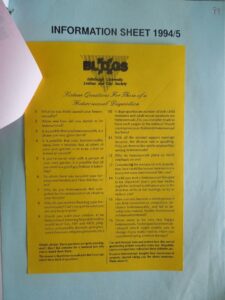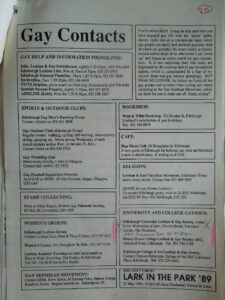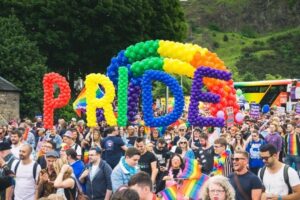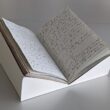Home University of Edinburgh Library Essentials
January 6, 2026
LGBTQI+ History Month: Discovering the Papers of the BLOG Society and the Letters of Christopher Isherwood
Posted on March 17, 2023 | in Archive Collections, LGBT+ History Month, Uncategorized, Volunteers | by lbeattieAsh Mowat is one of our volunteers in the Civic Engagement Team. Ash has been looking into the papers of the BLOG society and the letters of Christopher Isherwood in our archives and shares that information with us here.
Introducing Ash: I was born and have lived in Edinburgh most of my life. I attended University of Glasgow in the late 1980s where I hoped to complete an honours degree in English literature, but unfortunately due to ill health I was only able to obtain a degree at ordinary level. I have diverse interests in literature, the visual arts and science and history. I also worked for almost 25 years in social housing and have a passion for social justice, and equalities.
The University of Edinburgh’s Bisexual, Lesbian and Gay Society (also known as BLOG)
I reviewed some documents of the University’s Bisexual, Lesbian and Gay society BLOG (later made more inclusive and expanded to include Transgender in the title) BLOG, that was founded in 1973. [1] It is now known as PrideSoc. [2]
Having such a society in place is a hugely valuable resource to students. Starting at University itself can, whilst being exciting, can also be daunting to many, perhaps moving to a new city of even country, and having to adjust to living independently often for the first time. More so if from a potentially marginalised group such as LGBT+. For some of the years in this archive there were still some legal barriers to gay sex, and even when those were removed, the media’s and societal attitudes on queer people were often hostile throughout the end of the last century and beyond. Things are much better in Scotland today but still far from perfect, with transgender and non-binary people often exposed to hostile attitudes.
The papers in the archive cover the period from 1973 to 1999, although due to data protection requirements, only publicity and constitution papers etc. are available to view. This is an interesting period in LGBTQI+ history coming a few years after the partial decriminalisation of gay sex between men in 1967 (much later date of 1980 in Scotland) and subsequent period of greater gay liberation, only for the devastating impact of AIDS to emerge from the early 1980s.
A useful timeline on UK LGBTQI+ history can be found here.[3] Whilst it is encouraging that progress has been made in the UK, it is disturbing that it was as recently as 1992 that the World Health Organisation removed homosexuality as a mental disorder, and that the controversial School censorship on LGBTQI+ “promotion” Clause 28 was only repealed in England in 2003. Further, there is still a lot of toxic media debate on transgender rights in the UK. We should also be mindful of friends across the world in the many countries where same sex relationships are illegal.

The picture above, from the BLOG papers, above a very amusing and affective piece, transposing the erroneous stances taken against gay people in terms of being a chosen lifestyle, something that you’ll grow out of, or as something to keep secret from others. Instead here the same lame, lazy judgements are imposed on the “heterosexual disposition”.


Above is a handwritten copy of the constitution of BLOG from 1993 outlining the general principles of the organisation. It is noteworthy that at this time transgender people had not been incorporated into the membership. A further curiosity is the clause that “it is recognised that this Lesbian and Gay Society cannot, so does not intend to try to, fully meet the needs of bisexual students at Edinburgh University, though they are welcome to join and take part”. This reveals an historic tendency to not fully embrace the validity of bisexuality, something happily not reflected in the group’s current constitution.
Finally from 1989, a list of gay groups and societies of the time, including advice and support as well as leisure and recreational activities.
One of the outlets above is West and Wide Bookshop no longer operating. This was founded by Sigrid Nielsen and Bob Orr who previously opened the Lavender Menace in 1982, the first LGBT+ bookshop in Scotland and only the second opened in the UK at the time.[4] In addition to book sales, they also sold magazines, held events, and produced their own newsletter, which in addition to covering gay issues, also promoted antiracism and opposition to sexist thinking and practices.
Whilst the store itself closed in 1986, it now operates as a sometimes pop-up bookshop and archive committed to retaining out of print works in their library. Volunteers are welcome to participate in their project.[5]
Christopher Isherwood: Last Drawings and manuscript material at University of Edinburgh
I viewed the above in the archives, the drawings of Isherwood made by his lover of over 30 years Don Bachardy. [6] Firstly, however, a little biography and discussion on his writing.
Isherwood was born in England in 1904, although later settled and adopted nationality in the USA. He was a gay man and writer of fiction and non-fiction, with several of his works being adapted for the screen, whilst he also wrote for the cinema.[7]
One of his most celebrated works is a series of short stories later published as Goodbye to Berlin in 1939. These semi-autobiographical tales feature a version of Isherwood as the narrator, and reflect upon his years in Berlin in the 1930s, where he was required to take on work as a tutor of English language to earn a living whilst working on his fiction.
Rereading this recently after many years, it appears in places quite sketchy and incomplete, however to be fair Isherwood remarks in the introduction that he originally intended these stories to be developed into a longer piece, so the reader should understand this and view these accordingly.
In this collection, Isherwood brilliantly captures the abject poverty and sometimes squalor in Berlin at the time, contrasted with some of the lavish living of some of the rich families he comes to teach. He describes the libertarian attitudes, sexual freedoms and nightlife of the Weimar republic cabaret and club scene. His characters are always colourful: sometimes beautiful, grotesque, opportunistic, unreliable and spirited. The narrator can adopt a tone that can appear judgemental on other characters whilst not revealing fully his own views and opinions, which can be jarring. They are all, however, carefully crafted and brought to life with vibrant decadent dialogue.
Whilst the references to gay sex are muted, they would have to have been so given the date of their publication, their very inclusion and the sometimes licentious behaviours of the characters must have proved quite brave and shocking for the period.
The most famous character in the book is that of Sally Bowles, whom Isherwood based on the real life journalist, activist and writer Jean Ross.[8] Ross was unhappy at her portrayal in the book and the later film inspired by it, Cabaret, as she felt Bowles was too frivolous a character only interested in hedonistic pursuits, whilst Ross was an intellectual, a committed political activist (she was and remained a communist) and engaged in writing and creative activities. She was also appalled at the anti-Semitic language used by Bowles in the book (she refers to “a filthy Jew”), when Ross was a fervent antifascist and deplored anti-Semitism. Despite those factors, the character of Sally Bowles is a powerful example of a defiant free spirit in stark contrast to the emerging fascist state.
In Isherwood’s defence here, to honestly record the history leading up to the coming to power of the Nazi government, it is essential to reflect the anti-Semitic views that many German citizens held. Sometimes in these stories, the unchallenged anti-Semitic remarks are problematic, and some of the Jewish characters described come close, at least to me, to displaying the stereotypical racist tropes such as an avidity for wealth. Isherwood himself later regretted some of the harsh portrayal of his characters,[9] and his biographer explored his attitudes to Jewish people as explored in this review.[10]
The stories, covering the three years up to the appointment of Hitler, do reflect the rising oppressive dark shadow that is the emergence of the Nazis, fuelled by the poverty suffered by the people and by exploiting the lazy, diverting scapegoat of Jewish culpability for Germany’s hardships.
The Cabaret movie of 1972 does a good job at depicting the brutality of the insidious Nazi rise to power, and because of the later release date, is more frank and celebratory on the depictions of gay lives and nightlife scenes. The music and score were written by John Kander and Fred Ebb, and the songs formed a crucial piece of the narrative and were so effective in depicting the conflicting worlds of the flamboyant night club scenes, the glaring contractions between poverty and wealth, and the complexity and humanity of those living though this period.
Drawings of Christopher Isherwood by Don Bachardy (SC F 478)
I viewed the book of these extraordinary drawings by the accomplished artist and lover for over thirty years of Isherwood, completed in the last few months of Isherwood’s life during the mid-1980’s as he was dying from prostate cancer. Due to data protection issues, no images from the collection can be posted here.
In the introduction John Russell writes” There was never a book like this before, and I doubt that there will ever be one like it again. It is a book about what it means for one human being to take responsibility for another.”
And Don Bachardy himself explains of the process “Because of Dan’s help (a fellow artist), I was able to find the time to draw Chris through these last few months. I had almost daily drawing sessions with him and was fairly often able to do as many as nine or ten a day, sometimes fewer”.
It’s such a clear demonstration of the love between these two men that such determination, stamina and resilience was found to complete this art in such circumstances. The drawings themselves, monotone sketches black on white, are sometimes a portrait of the face only but also include full body nude postures. They can be sparsely formed, a matter of just a few lines, or be much more detailed and refined. In all cases, they are easily recognisable and capture the features and expressions of the subject.
The face is often the most defined area detailed, the lived lifelines across the forehead and glint captured in the eyes. The hands, a writer’s tools, are also drawn and captured carefully. They are remarkably bold and frank in honestly portraying suffering, as there is no soft focus or shielding from the truth. They reflect upon a life lived in full by a writer who in his work sought to observe and record the diverse lives of others, and chose to have his own journey from illness towards death to also be preserved in this art.
Don Bachardy has had an extensive output as an artist and still lives in the home in Santa Monica California, where and Isherwood first occupied together over 50 years ago.[11]
Christopher Isherwood letters from the University of Edinburgh Archive (MS 3216)
There are a couple of revealing remarks from Isherwood here, the first from a letter of 11.7.1967 to a Harry Heckford: “One fact I don’t mention. I wrote to some Government office offering my services in an intelligence job if war broke out…in late September of 1938 I was preparing to take part in the war effort, three months later, I had discovered I was a pacifist!”
In another letter to the same recipient sent in October 1971 he replies “No, I never had any direct trouble during the McCarthy era, though I was sometimes questioned about my friends. You see, as a naturalised citizen, I had been thoroughly investigated by the FBI-also as a pacifist-so the witch hunters didn’t dare to challenge their verdict”. This is interesting as the McCarthy trials focused not only on suspected communists but also gay people in public office.[12]
The Edinburgh Pride March
Outside of the University society, Edinburgh also has a vibrant annual LGBT Pride march and festival held every June. From humble beginnings of “lark in the park” in 1988 (with actor Ian McKellen amongst the speakers)[13] with only a few hundred attendees, the first Pride march was held in 1995. [14]
A further resource on queer history in Edinburgh and Scotland can be found here. [15]
Pride now has thousands of participants, and is a vital, colourful and celebratory display of LGBTQI+ diversity and empowerment.

[1] https://archives.collections.ed.ac.uk/repositories/2/archival_objects/
[2] https://www.eusa.ed.ac.uk/activities/view/pridesoc
[3] https://www.bl.uk/lgbtq-histories/lgbtq-timeline
[4] https://en.wikipedia.org/wiki/Lavender_Menace_Bookshop
[5] https://lavendermenace.org.uk/
[6] https://www.ed.ac.uk/information-services/library-museum-gallery/crc/research-resources/lgbtq-sources
[7] https://en.wikipedia.org/wiki/Christopher_Isherwood
[8] https://en.wikipedia.org/wiki/Jean_Ross
[9] https://en.wikipedia.org/wiki/Goodbye_to_Berlin
[10] https://www.theguardian.com/books/2004/may/23/biography.features2
[11] http://www.donbachardy.com/biography.php
[12] https://en.wikipedia.org/wiki/Lavender_scare
[13] https://www.facebook.com/EqualityNetwork/posts/lark-in-the-park-28th-may-198830-years-ago-today-in-protest-at-section-28-which-/10156383303877378/
[14] https://prideedinburgh.co.uk/our-history/
[15] https://www.ourstoryscotland.org.uk/heritage/assocSupp/Edinburgh1977.htm
Collections
 Hill and Adamson Collection: an insight into Edinburgh’s past
My name is Phoebe Kirkland, I am an MSc East Asian Studies student, and for...
Hill and Adamson Collection: an insight into Edinburgh’s past
My name is Phoebe Kirkland, I am an MSc East Asian Studies student, and for...
 Cataloguing the private papers of Archibald Hunter Campbell: A Journey Through Correspondence
My name is Pauline Vincent, I am a student in my last year of a...
Cataloguing the private papers of Archibald Hunter Campbell: A Journey Through Correspondence
My name is Pauline Vincent, I am a student in my last year of a...
Projects
 Cataloguing the private papers of Archibald Hunter Campbell: A Journey Through Correspondence
My name is Pauline Vincent, I am a student in my last year of a...
Cataloguing the private papers of Archibald Hunter Campbell: A Journey Through Correspondence
My name is Pauline Vincent, I am a student in my last year of a...
 Archival Provenance Research Project: Lishan’s Experience
Presentation My name is Lishan Zou, I am a fourth year History and Politics student....
Archival Provenance Research Project: Lishan’s Experience
Presentation My name is Lishan Zou, I am a fourth year History and Politics student....

